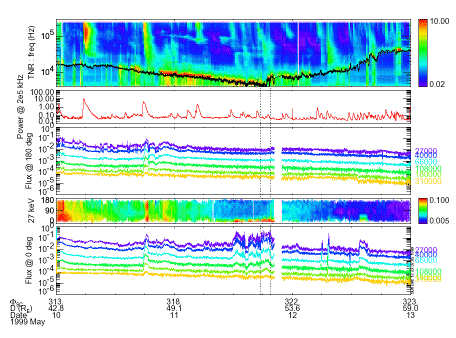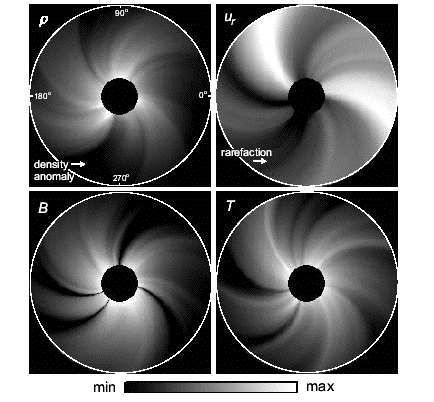
The "disappearing solar wind" revisited
Indeed, the solar wind did something drastic on May 10-11, 1999. Its density dropped to near 0.2 particles per cc, and its speed plummeted as well. This combination greatly reduces the "ram pressure" on the Earth's magnetosphere, which forms a magnetic obstacle to the solar-wind flow. Accordingly the magnetosphere inflated hugely, perhaps to its largest physical size since the era of measurement in space ("space weather") began. The WIND view of the plasma parameters in the solar wind illustrates the phenomenon, as it did in our previous nugget:
| The solar wind as it appeared during its "disappearance" in May, 1999, as viewed by the WIND spacecraft. The uppermost panel has the key information: the density of the solar wind dropped briefly to as low as 0.2 particles/cm^3. The local plasma frequency at the spacecraft scales as the density, shown in the color bar at the upper right. The figure actually illustrates this in terms of a direct observation of electromagnetic noise at the plasma frequency, which depends only upon the plasma density in the environment of the spacecraft. Normally the density of the solar wind near one A.U. is a factor of 10-100 higher. This low density was accompanied by a low flow speed, not shown on this figure. |

|
Following the press release about this phenomenon, much research focused on its explanation. When does the density of the solar wind drop so precipitously, and what does it typically mean? It turns out that this example is not the most extreme case, but (hmmmm!) the previous record-holder was in late 1979 (Richardson et al., GRL 27, 3761, 2000; this is one of the studies following the phenomenon of 1999). This is nearly two 11-year sunspot cycles (one Hale cycle) earlier - is this a clue?
|
The solar corona, as viewed by Yohkoh SXT in soft X-rays, as
it developed during the May 1999 event, in movie form.
One can see from the time-series panels at the top (which show solar-wind
density) that this was the most extreme case, but that even over this
limited time interval other examples of low-density flows occurred.
This movie was not included in our previous nugget but the conclusion remains the same: there was no obvious large-scale coronal restructuring associated with the solar-wind phenomena. |

Javascript (large) ; GIF (large) ; MPEG (411 KB) |
Density drops in the solar wind are not so completely unusual, but Richardson et al. point out that they usually they follow flare ejecta. These are closely related to CMES (Coronal Mass Ejections) and solar flares. Physically this makes sense - fast ejections could result in evacuated regions following them, for essentially hydrodynamic reasons - but a fast ejection would not readily explain a low wind speed. So this May 1999 phenomenon probably is not that sort of effect. The novelty here, as explained in the paper by Usmanov et al. (GRL 27, 3765, 2000) is that something unique may be happening. Every eleven years, the solar magnetic field flips its polarity. This is what distinguishes the 22-year Hale cycle from the 11-year sunspot cycle. When the solar field flips, the solar wind must follow suit, but the physical mechanism for this process is almost unmanageable theoretically (see the Usmanov paper for a fuller description). These clever people suggest that a slow flow associated with the field flip results in the observed rarefaction, as illustrated in the figures below (left, cartoon; right, simulation of the wind, but not the corona):

|

|
Let us adopt the field-flip idea as a working hypothesis. How would we recognize its action in the interface zone between the corona and the solar wind?
| Evidence presented by Usmanov et al. that the field-flip coincided with the peculiar solar-wind conditions. These are synoptic maps of the coronal magnetic field, one per rotation period of about 27 days. These maps show the distribution of magnetic polarity at the top of the corona (bottom of the solar wind) in a simple model - light grey is one polarity, dark grey the other; the heavy line between them is the projection of the heliospheric current sheet. The time sequence is top to bottom, left to right, and one can see that the field becomes quite complicated after rotation 1949. This rotation, it turns out, contains May 11, 1999, leading to the conjecture of Usmanov et al. that the field flip involved a sudden burst of slow wind, which led to the rarefaction observed. |

|
Maybe a better name would be "dysphotosphere" or maybe "apophotosphere," but advice on Greek roots would be appreciated. What we mean by this is the domain linking the solar corona and the solar wind, which is almost un-observable at present. We typically observe the corona using "remote sensing" instruments ("telescopes" to astronomers), whereas we observe the solar wind typically by direct in-situ measurement of plasma parameters (such as density). In between these different volumes, observed by different techniques, the physics changes significantly. Simplifying matters a bit, the magnetic field determines the structure of the corona, whereas the gas determines the structure of the solar wind. The latter is a lot more intuitive to beings such as ourselves, who grow up and live in an essentially non-magnetic locale.
The point about the "helionoseeosphere" is that it can't readily be imaged, nor easily probed in situ. It is too tenuous for the usual astronomical techniques, and it has been thought too costly to send spacecraft into; the previous record-setting spacecraft, HELIOS, penetrated only to 0.3 A.U., two-thirds of the way to the Sun from the Earth. We need to understand the volume 2-20 R_sun (0.01 - 0.1 A.U.), a true frontier for exploration. So we end this nugget with a plea for new observing programs, including both telescopes and space probes, that can follow the gyrations of the field in this hard-to-observe volume.
July 5, 2002
Hugh Hudson (hudson@lmsal.com) and Nariaki Nitta (nitta@lmsal.com) with thanks to an ad hoc discussion group - Davin Larson, Steve Ledvina, Yan Li, Bob Lin, and Janet Luhmann, (all of UC Berkeley, all initial L!), plus Brian Welsch (also of UCB) today at UCB. Perhaps Brian should change his name to Lwelsch.